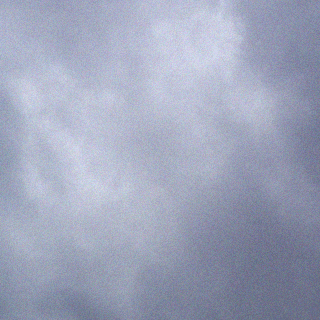The Southeastern United States is home to a wide variety of native plants that attract hummingbirds, providing them with nectar and habitat throughout the year. These plants thrive in the region’s warm climate and diverse ecosystems.
Native Flowers
Scarlet Sage (Salvia coccinea)
Key Characteristics
Scarlet Sage (Salvia coccinea), also known as Tropical Sage or Blood Sage, is a native herbaceous perennial that is highly valued for its 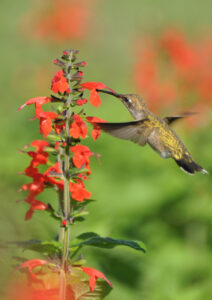 vibrant, tubular red flowers. These blooms are rich in nectar and attract hummingbirds, butterflies, and bees. Scarlet Sage is easy to grow, self-seeds readily, and adds a pop of color to gardens from spring through fall.
vibrant, tubular red flowers. These blooms are rich in nectar and attract hummingbirds, butterflies, and bees. Scarlet Sage is easy to grow, self-seeds readily, and adds a pop of color to gardens from spring through fall.
- Height
Scarlet Sage typically grows between 2 to 4 feet tall and spreads 1 to 2 feet wide. Some cultivars may reach up to 5 feet in height, making it versatile for garden beds, borders, or containers.
- Bloom Time
This plant blooms from late spring through fall, offering a long-lasting nectar source for pollinators. Deadheading encourages repeat blooming and keeps the plant looking fresh throughout the growing season.
- Light Requirement
Scarlet Sage thrives in full sun but can tolerate partial shade. For optimal flowering, plant it in locations that receive at least 6 hours of direct sunlight daily.
- Soil Preference
Scarlet Sage prefers well-drained soil with moderate moisture levels. It adapts to various soil types, including sandy, loamy, or slightly clay soils. While drought-tolerant once established, regular watering during dry spells ensures better flowering.
- Natural Habitat and Growing Conditions
Native to the southeastern United States and Mexico, Scarlet Sage thrives in USDA zones 7–10. It is commonly found in open woodlands, 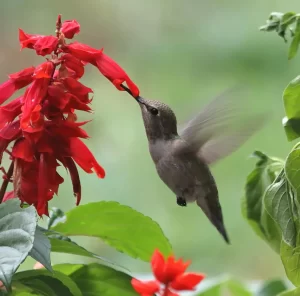 meadows, and coastal areas. In cooler climates (zones 6 and below), it can be grown as an annual.
meadows, and coastal areas. In cooler climates (zones 6 and below), it can be grown as an annual.
- Ecological Benefit
Scarlet Sage is a magnet for hummingbirds due to its tubular flowers that perfectly suit their long beaks and tongues. Butterflies and bees also flock to its blooms for nectar. Additionally, its seeds provide food for small birds like finches. By planting Scarlet Sage, gardeners support pollinators while enhancing biodiversity.
- Garden Uses
Scarlet Sage is versatile in the garden and works well in pollinator gardens, cottage-style landscapes, or naturalized settings. Its bright flowers add bold color to borders, pathways, or mixed flower beds. It can also be grown in containers for patios or balconies where hummingbirds frequently visit.
- Why Choose Scarlet Sage?
Scarlet Sage is an excellent choice for gardeners seeking a low-maintenance plant that attracts pollinators while adding vibrant color to their outdoor spaces. Its adaptability to various soil types and climates makes it a reliable performer in most gardens. Additionally, its self-seeding ability ensures it will return year after year with minimal effort, creating a consistent habitat for hummingbirds and other wildlife.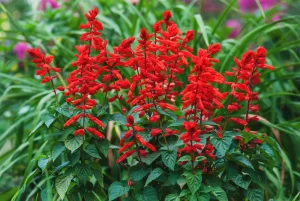
What Are the Unique Characteristics of This Plant That Make It Attractive to Hummingbirds?
The bright red tubular flowers of Scarlet Sage are specifically designed for hummingbirds. Their shape allows easy access to nectar while minimizing competition from other pollinators. The extended bloom period ensures a reliable food source during critical times like migration and breeding seasons. Scarlet Sage’s ability to thrive in sunny spots makes it ideal for gardens where hummingbirds are active. Its self-seeding nature also ensures it returns year after year, creating a consistent habitat for these feathered jewels.
Video: Scarlet Sage Salvia, one of the queens of my garden!
Coral Honeysuckle (Lonicera sempervirens)
Key Characteristics
Coral Honeysuckle (Lonicera sempervirens) is a native, twining woody vine celebrated for its vibrant, tubular flowers that range in color from 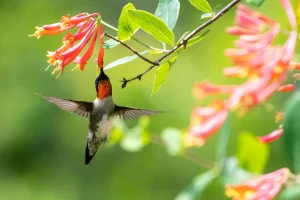 scarlet red to reddish-orange with yellow throats. These blooms are rich in nectar and attract hummingbirds, butterflies, and bees. The vine also produces bright red berries in late summer to fall, which serve as a food source for birds.
scarlet red to reddish-orange with yellow throats. These blooms are rich in nectar and attract hummingbirds, butterflies, and bees. The vine also produces bright red berries in late summer to fall, which serve as a food source for birds.
- Height
Coral Honeysuckle can grow 6–15 feet long and spread 3–6 feet wide. Its climbing habit makes it ideal for trellises, fences, arbors, or even as ground cover in naturalized landscapes.
- Bloom Time
This vine blooms profusely from spring through summer, with sporadic flowering continuing into fall. Its extended bloom period ensures a reliable nectar source for pollinators throughout the growing season.
- Light Requirement
Coral Honeysuckle thrives in full sun to partial shade. Planting it in full sun encourages abundant flowering, while partial shade may result in fewer blooms but still healthy growth.
- Soil Preference
This adaptable vine grows well in well-drained soils ranging from sandy to clay types. It tolerates both acidic and slightly alkaline soils and  performs best with moderate moisture levels.
performs best with moderate moisture levels.
- Natural Habitat and Growing Conditions
Native to the eastern United States, Coral Honeysuckle is found in sandhills, floodplain forests, hardwood hammocks, and open woodlands. Hardy in USDA zones 4–9, it is semi-evergreen in warmer climates and deciduous in colder regions.
- Ecological Benefit
Coral Honeysuckle is a magnet for pollinators like hummingbirds, butterflies, and moths due to its nectar-rich flowers. Birds such as cardinals enjoy its berries as a food source. Additionally, it serves as a larval host plant for Spring Azure butterflies and Snowberry Clearwing moths.
- Garden Uses
Coral Honeysuckle is perfect for vertical gardening on trellises or fences. It can also be used as ground cover or trained into a weeping shrub form. Its vibrant blooms add bold color to pollinator gardens or cottage-style landscapes.
- Why Choose Coral Honeysuckle?
Coral Honeysuckle is an excellent choice for gardeners seeking a low-maintenance vine that attracts wildlife while adding beauty to their outdoor 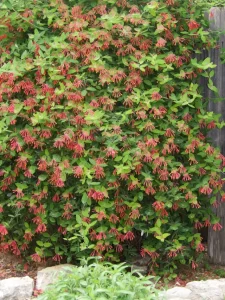 spaces. Its adaptability to various soil types and climates makes it versatile and reliable. The combination of nectar-rich flowers and bird-friendly berries ensures year-round ecological benefits.
spaces. Its adaptability to various soil types and climates makes it versatile and reliable. The combination of nectar-rich flowers and bird-friendly berries ensures year-round ecological benefits.
What Are the Unique Characteristics of This Plant That Make It Attractive to Hummingbirds?
The tubular shape of Coral Honeysuckle’s flowers is perfectly suited for hummingbirds’ long beaks and tongues, allowing them easy access to nectar. The bright red color acts as a visual beacon for these birds, who are naturally drawn to vibrant hues. The extended bloom period provides a consistent food source during critical times like breeding and migration seasons. Additionally, its climbing habit places the flowers at accessible heights for hummingbirds while creating stunning vertical displays in the garden.
Video: The Perfect Native Vine? Why Coral Honeysuckle Deserves a Spot in Your Garden!
Eastern Red Columbine (Aquilegia canadensis): A Hummingbird Friendly Gem
Key Characteristics
Eastern Red Columbine (Aquilegia canadensis) is a perennial wildflower recognized for its striking red and yellow, bell-shaped flowers. This 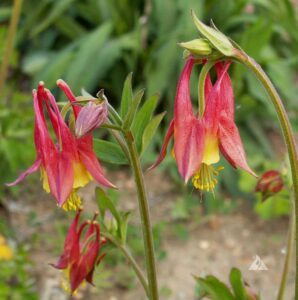 native plant is a favorite among gardeners and wildlife enthusiasts.
native plant is a favorite among gardeners and wildlife enthusiasts.
- Zone
It thrives in USDA hardiness zones 3–8, making it adaptable to a variety of climates across North America
.
- Height
The plant typically grows between 1–3 feet tall, with a spread of 12–18 inches
.
- Bloom Time
Eastern Red Columbine blooms from late spring to early summer, coinciding with the return of ruby-throated hummingbirds from migration
.
- Features
Its pendulous flowers feature spurred petals resembling eagle talons, which are filled with nectar. The foliage is lobed and gray-green, adding ornamental appeal even after flowering
.
Natural Habitat
This plant naturally occurs in rocky woodlands, slopes, and open prairies throughout eastern North America. It thrives in areas with good 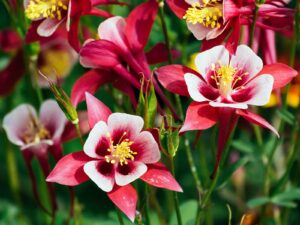 drainage and moderate moisture
drainage and moderate moisture
.
Light Requirement
Eastern Red Columbine grows well in partial shade but can tolerate full sun with adequate moisture
.
Soil Preference
It prefers organically rich, moist soils but adapts to various conditions as long as drainage is good
.
Natural Habitat and Growing Conditions
This resilient wildflower is drought-tolerant once established. It self-seeds readily, forming colonies that enhance naturalized gardens or woodland edges
.
Ecological Benefit
The flowers are a vital nectar source for ruby-throated hummingbirds, hawk moths, and bees. Additionally, it serves as a host plant for the Columbine Duskywing butterfly
.
Garden Uses
Eastern Red Columbine works well in pollinator gardens, woodland borders, or shady cottage gardens. Its deer-resistant nature makes it ideal for areas prone to browsing mammals
.
Why Choose Eastern Red Columbine?
This native plant combines beauty with ecological value. Its vibrant blooms attract hummingbirds while adding color and texture to the garden.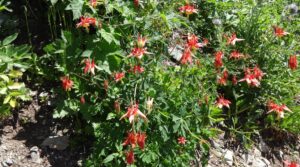
Unique Characteristics That make Red Columbine attractive for Hummingbirds
- Attractive Color
The vibrant red and yellow hues of Eastern Red Columbine (Aquilegia canadensis) are highly appealing to hummingbirds. These bright colors act as visual beacons, drawing hummingbirds to the flowers from a distance, especially during their migration.
- Flower Shape
The pendulous, bell-shaped flowers with elongated spurs are perfectly designed for hummingbird beaks. The spurred petals allow hummingbirds to access nectar deep within the flower, ensuring a mutually beneficial relationship between the plant and its avian visitors.
- Nectar Content
Eastern Red Columbine produces nectar with a high sugar concentration, making it a rich energy source for hummingbirds. The abundance of nectar ensures that these birds return repeatedly, boosting pollination success.
- Blooming Sequence
This plant blooms prolifically from late spring to early summer, coinciding with the arrival of ruby-throated hummingbirds in many regions. Its extended blooming period provides a reliable food source for these birds during critical times of migration and nesting.
- Adaptability
Eastern Red Columbine thrives in various environments, including woodland edges, rocky slopes, and shaded gardens. Its ability to grow in partial shade or full sun makes it accessible to hummingbirds across diverse habitats.
- Pollination Partnership
Hummingbirds are the primary pollinators of Eastern Red Columbine. As they feed on nectar, their movements transfer pollen between flowers, ensuring successful fertilization. This partnership exemplifies the intricate connection between wildlife and native plants.
Video: How to Grow Columbine, Germinate Seed, Care for
Learn all the information you need to grow Columbine Flowers, aka Wild Columbine, aka Eastern Red Columbine, Aquilegia canadensis. Grow this hardy perennial (USDA zones 3-8) in full sun to shade. Columbine will grow just about anywhere as long as the soil drains well. But in this video I teach you how to germinate columbine seeds, save seeds, identify Columbine, and numerous other tips from pests to diseases and how to avoid them. I also show you just how much Columbines Spread.
Conclusion
Eastern Red Columbine is not only a stunning addition to gardens but also an ecological powerhouse that supports hummingbirds and other pollinators. Its vibrant colors, specialized flower shape, rich nectar content, extended blooming period, adaptability, and symbiotic relationship with pollinators make it an essential choice for wildlife-friendly landscapes. By planting Eastern Red Columbine, gardeners can enjoy its beauty while contributing to the conservation of hummingbirds and their habitats.
Cardinal Flower (Lobelia cardinalis) A Hummingbird Favorite
Key Characteristics
Cardinal Flower (Lobelia cardinalis) is a striking herbaceous perennial native to North America. Known for its vibrant red blooms, it stands out 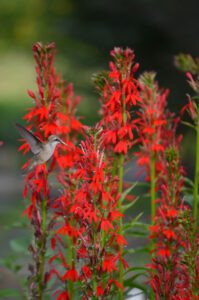 as one of the best plants for attracting hummingbirds. This short-lived perennial self-seeds readily, ensuring its presence in gardens for years.
as one of the best plants for attracting hummingbirds. This short-lived perennial self-seeds readily, ensuring its presence in gardens for years.
- Zone
Hardy in USDA zones 3–9, Cardinal Flower thrives in a wide range of climates.
- Height
The plant grows to a height of 2–4 feet, with a spread of 1–2 feet, making it suitable for borders and rain gardens.
- Bloom Time
Cardinal Flower blooms from mid-summer to early fall, typically July through September, lasting for over a month.
- Features
Its tall spikes are adorned with tubular flowers that open sequentially from the bottom to the top, creating prolonged visual interest and nectar availability. The lance-shaped leaves add texture to the plant’s appearance.
Natural Habitat
Cardinal Flower is naturally found in wetlands, streambanks, swamps, and moist woodlands across North America.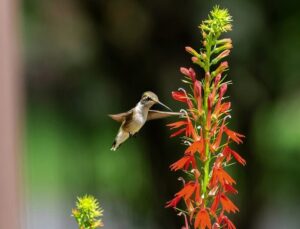
Light Requirement
It prefers full sun to partial shade. In hotter climates, afternoon shade can help protect the plant from excessive heat.
Soil Preference
This plant thrives in moist to wet soils rich in organic matter. It tolerates occasional flooding but struggles in dry or barren conditions.
Growing Conditions
Cardinal Flower flourishes in consistently moist environments such as rain gardens or along ponds and streams. Mulching helps retain soil moisture and protect roots during colder months.
Ecological Benefit
Its nectar-rich flowers are tailored for hummingbirds and also attract butterflies and bees. Cardinal Flower plays a key role in supporting pollinator populations and biodiversity.
Garden Uses
Ideal for rain gardens, borders, and native plantings, Cardinal Flower adds height and vivid color to moist areas. It pairs well with other moisture-loving plants like Great Blue Lobelia and marsh milkweed.
Why Choose Cardinal Flower?
Cardinal Flower combines beauty with ecological value. Its vibrant blooms attract hummingbirds while enhancing garden aesthetics. Its ability to 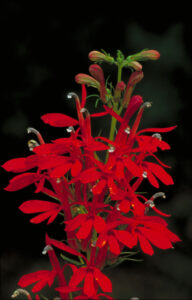 thrive in challenging wet conditions makes it a standout choice.
thrive in challenging wet conditions makes it a standout choice.
What Makes Cardinal Flower Attractive to Hummingbirds?
- Attractive Color
The brilliant scarlet blooms of Lobelia cardinalis are irresistible to hummingbirds. The vivid red acts as a visual signal, drawing these birds to
the plant from afar.
- Flower Shape
The tubular flowers are perfectly adapted for hummingbird beaks and tongues, allowing easy access to nectar while ensuring pollination.
- Nectar Content
Cardinal Flower produces abundant nectar with high sugar content, providing an essential energy source for hummingbirds during migration and nesting seasons.
- Blooming Sequence
Its flowers open gradually from the bottom of the spike upward over several weeks, ensuring a continuous supply of nectar throughout its blooming period.
- Adaptability
This plant thrives in various environments, including wetlands and shaded areas. Its ability to grow in both full sun and partial shade makes it accessible to hummingbirds across diverse habitats.
- Pollination Partnership
Hummingbirds are the primary pollinators of Cardinal Flower. As they feed on nectar, their heads brush against the flower’s reproductive structures, transferring pollen between plants and ensuring genetic diversity.
Video: Complete Guide To The Cardinal Flower, Lobelia Cardinalis
Conclusion
Cardinal Flower is a stunning addition to wildlife-friendly gardens. Its vibrant color, specialized flower shape, rich nectar content, extended bloom time, adaptability, and symbiotic relationship with hummingbirds make it an ecological treasure. By planting Lobelia cardinalis, gardeners can enjoy its beauty while supporting pollinator populations essential for ecosystem health.
Jewelweed (Impatiens capensis)
Jewelweed, scientifically known as Impatiens capensis, is a captivating wildflower native to North America. Commonly called orange jewelweed, spotted jewelweed, or touch-me-not, this annual herb is celebrated for its vibrant flowers, ecological benefits, and unique seed dispersal mechanism. In this blog post, we’ll explore its key characteristics, natural habitat, growing conditions, ecological roles, and why it’s an excellent choice for your garden.
Key Characteristics
Zone:
Jewelweed thrives in USDA Hardiness Zones 2 through 11, making it adaptable to a wide range of climates.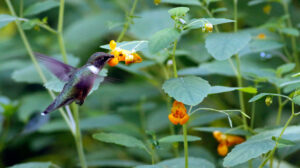
Height:
This plant typically grows between 3 and 5 feet tall depending on environmental conditions.
Bloom Time:
Jewelweed blooms from mid-summer to early fall (July–October), providing a long-lasting display of orange or yellow flowers dotted with reddish spots.
Features:
-
Leaves: Oval-shaped with scalloped edges and microscopic hairs that trap air, giving them a waterproof appearance. Dew beads up on the leaves, creating a sparkling effect that inspired the name “jewelweed.”
-
Flowers: Trumpet-shaped blooms hang delicately on slender stalks. The orange flowers attract hummingbirds, while the yellow variety appeals to bumblebees.
-
Seed Dispersal: Jewelweed’s seed pods burst explosively when touched—a phenomenon known as “explosive dehiscence.”
Natural Habitat
Jewelweed is commonly found in moist, shady areas such as low woodlands, streambanks, bogs, and drainage ditches. It thrives in 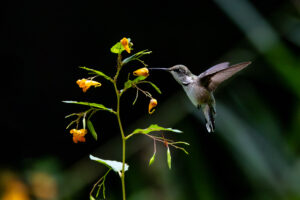 environments with consistent moisture and partial to full shade.
environments with consistent moisture and partial to full shade.
Light Requirements
This plant prefers partial to full shade but can tolerate dappled sunlight. Jewelweed’s adaptability to low-light conditions makes it ideal for woodland gardens or shaded wetland areas.
Soil Preference
Jewelweed thrives in moist, rich soils with high organic matter content. It prefers slightly acidic to neutral pH levels and can tolerate soggy conditions that many other plants cannot endure. Compost or rotted manure can improve soil quality for optimal growth.
Growing Conditions
In its natural environment, jewelweed grows abundantly in areas with consistent moisture and shade. It tolerates occasional flooding and can thrive in disturbed soils. Jewelweed self-sows vigorously once established, forming dense colonies that suppress invasive weeds.
Ecological Benefits
Jewelweed plays an essential role in supporting local ecosystems:
-
Pollinator Magnet: Its nectar-rich flowers attract hummingbirds, bees, butterflies, and other pollinators.
-
Seed Dispersal: The explosive seed capsules ensure propagation while providing food for small animals like mice and birds.
-
Companion Plant: Jewelweed often grows near poison ivy and is known for its sap’s ability to soothe skin irritations caused by poison ivy or insect bites.
Garden Uses
Jewelweed is a versatile addition to naturalistic gardens: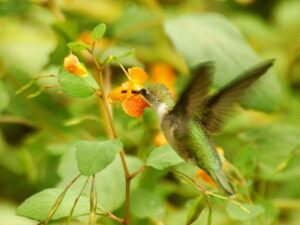
-
Rain Gardens: Ideal for wet areas prone to flooding.
-
Pollinator Gardens: Attracts hummingbirds and beneficial insects.
-
Erosion Control: Stabilizes soil along streambanks or slopes.
-
Medicinal Gardens: Known for its traditional use as a remedy for skin irritations like poison ivy rash.
Unique Characteristics That Make Jewelweed Attractive for Hummingbirds
Attractive Color
Hummingbirds are naturally drawn to the bright orange hues of jewelweed’s flowers, which act as visual beacons signaling nectar availability.
Flower Shape
The tubular structure of jewelweed’s flowers aligns perfectly with the long beaks of hummingbirds, enabling efficient nectar extraction while facilitating pollination.
Nectar Content
Jewelweed produces abundant nectar throughout its blooming period, ensuring a reliable food source for hummingbirds during migration and nesting seasons.
Blooming Sequence
Jewelweed’s blooming sequence spans several months (July–October), ensuring that pollinators have access to nectar throughout the growing season. The staggered bloom time also allows gardeners to enjoy vibrant flowers over an extended period without replanting or intensive care.
Adaptability
Few plants can match jewelweed’s adaptability:
-
Moisture Tolerance: Thrives in consistently moist soils but can endure short periods of drought once established.

-
Shade Tolerance: Prefers partial shade but can grow in full shade.
-
Flood Resistance: Survives occasional flooding in rain gardens or wetlands.
-
Self-Sowing Capability: Forms dense colonies through vigorous self-seeding.
-
Natural Pest Resistance: Has few pest issues and is generally resistant to deer browsing due to its high water content.
This adaptability makes jewelweed an excellent choice for eco-friendly gardens prioritizing sustainability.
Pollination Partnership
Jewelweed exemplifies the intricate relationship between plants and their pollinators:
-
Hummingbirds as Primary Pollinators: The bright orange flowers are perfectly adapted for hummingbirds’ long beaks and tongues.
-
Bees & Butterflies: Bumblebees frequently visit jewelweed flowers alongside butterflies seeking nectar.
-
Dual Pollination Mechanism: Jewelweed employs both cross-pollination via pollinators and self-pollination during stressful conditions (cleistogamy), ensuring reproduction even when pollinators are scarce.
-
Ecosystem Impact: By supporting diverse pollinator species, jewelweed helps maintain healthy ecosystems that benefit other plants and wildlife.
Conclusion
Jewelweed (Impatiens capensis) is more than just a beautiful wildflower—it’s an ecological powerhouse that supports pollinators, stabilizes soils, and provides medicinal benefits. Whether you’re looking to enhance your garden’s biodiversity or add vibrant color to shaded areas, jewelweed is an excellent choice.
Its extended blooming sequence ensures consistent support for wildlife throughout the growing season while its adaptability makes it suitable for challenging garden conditions like wet soils or shaded spaces. Additionally, its unique partnership with hummingbirds showcases nature’s intricate design of mutual benefit between plants and pollinators.
By planting jewelweed in your garden, you’re not only cultivating beauty but also contributing positively to your local ecosystem—one vibrant orange flower at a time!
This video tells all you need to know about the awesome hummingbird magnet, Jewel weed. When it comes to pollinator gardening the native perennials get most of the attention. However, there are many native annuals that make a great addition to the pollinator garden. The common jewelweed, Impatiens capensis, and pale jewelweed, Impatiens pallida, are two eye-catching native annual species that have super showy blooms that attract a wide variety of bees, butterflies, and the beloved ruby throated hummingbird. The jewelweeds grow well in wetter shaded areas and also self-seed, so they do not have to be replanted every year.
Butterfly Weed (Asclepias tuberosa)
Butterfly weed, scientifically known as Asclepias tuberosa, is a stunning perennial plant native to North America. Known for its vibrant orange blooms and ecological importance, this member of the milkweed family is a favorite among gardeners and pollinators alike. In this blog post, we’ll explore its key characteristics, growing requirements, ecological benefits, and why it’s an excellent addition to any garden.
Key Characteristics
Zone:
Butterfly weed thrives in USDA Hardiness Zones 3 through 9, making it suitable for a wide range of climates across the United States.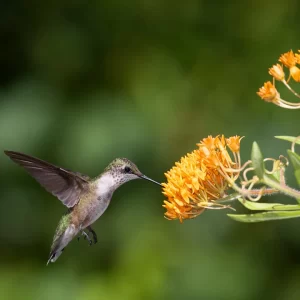
Height:
This plant typically grows between 1.5 and 3 feet tall, with a bushy growth habit that becomes more pronounced as it matures.
Bloom Time:
Butterfly weed blooms from late spring to early fall (April to September), providing a long-lasting display of vibrant flowers.
Features:
-
Flowers: Clusters of bright orange or yellow flowers measuring 2–4 inches in diameter. These blooms are rich in nectar and pollen, making them highly attractive to pollinators.
-
Leaves: Narrow, lance-shaped leaves with a medium green color.
-
Roots: A deep taproot that allows the plant to survive drought conditions and thrive in poor soils.
Natural Habitat
Butterfly weed is native to prairies, open woodlands, hillsides, and roadsides across the eastern and southern United States. It thrives in sunny locations with well-drained soils and is often found in areas with sandy or rocky substrates.
Light Requirements
Full sun is essential for butterfly weed to thrive. The plant requires at least six to eight hours of direct sunlight daily to produce its iconic blooms. While it can tolerate light shade, insufficient sunlight may reduce flowering.
Soil Preference
Butterfly weed prefers well-drained soils ranging from sandy to loamy textures. It tolerates slightly acidic to neutral pH levels and thrives in nutrient-poor soils where other plants might struggle. Its deep taproot helps it adapt to dry conditions, but overwatering or poorly drained soils can harm the plant.
Growing Conditions
In its natural environment, butterfly weed grows in sunny, open spaces with dry or well-drained soil. Its ability to withstand drought makes it ideal for regions with hot summers or sandy soils. The plant’s preference for undisturbed areas means it often thrives along roadsides, in meadows, or on rocky slopes.
Ecological Benefits
Butterfly weed plays a vital role in supporting local ecosystems:
-
Pollinator Support: Its nectar-rich flowers attract butterflies (especially monarchs), bees, hummingbirds, and other pollinators.
-
Host Plant: As a milkweed species, butterfly weed serves as a larval host plant for monarch butterflies. Monarch caterpillars rely on milkweed leaves as their primary food source during development.
-
Biodiversity Boost: By attracting diverse pollinators, butterfly weed contributes to the health of surrounding ecosystems and supports plant reproduction through cross-pollination.
Garden Uses
Butterfly weed is versatile and can enhance various garden settings:
-
Pollinator Gardens: A must-have for attracting butterflies and bees while supporting monarch conservation efforts.
-
Wildflower Meadows: Adds vibrant color and ecological value to naturalistic landscapes.
-
Rock Gardens: Thrives in rocky or sandy soils where other plants may struggle.
-
Erosion Control: Its deep taproot stabilizes soil on slopes or disturbed areas.
Why Choose Butterfly Weed?
Butterfly weed offers numerous benefits that make it an outstanding choice for gardens:
Unique Characteristics That Make Butterfly Weed Attractive for Hummingbirds
Butterfly weed (Asclepias tuberosa) is not only a favorite of butterflies but also an irresistible magnet for hummingbirds. Its unique traits make it particularly appealing to these tiny, energetic birds:
-
Attractive Color
Hummingbirds are naturally drawn to bright, warm colors like red, orange, and yellow, which signal the presence of nectar-rich flowers.

Flower Shape
The flower clusters of butterfly weed are composed of small, star-shaped blooms arranged in flat-topped umbels. Each individual flower has a tubular structure with reflexed petals and a prominent crown-like corona. This shape is perfectly suited to hummingbirds’ long beaks and tongues, allowing them to access nectar efficiently while facilitating pollination. The sturdy flower clusters also provide a stable landing platform for hummingbirds during feeding.
Nectar Content
Butterfly weed produces copious amounts of nectar, making it a reliable food source for hummingbirds throughout its blooming season. The high sugar content of the nectar provides the quick energy these birds need to sustain their rapid wingbeats and high metabolism. Additionally, the plant’s extended bloom time ensures that nectar is available over several months, supporting hummingbirds during critical periods such as migration.
Blooming Sequence
Butterfly weed’s blooming sequence spans several months (April–September), ensuring that pollinators have access to nectar throughout the growing season. The staggered bloom time also allows gardeners to enjoy vibrant flowers over an extended period without replanting or intensive care.
Adaptability
Few plants can match butterfly weed’s adaptability:
-
Drought Resistance: Thanks to its deep taproot, butterfly weed thrives in dry conditions where other plants may fail.
-
Soil Tolerance: It grows well in sandy, rocky, or nutrient-poor soils.
-
Low Maintenance: Once established, butterfly weed requires minimal watering and no fertilization.
-
Wide Climate Range: Suitable for USDA Zones 3–9, it handles both freezing winters and hot summers with ease.
This adaptability makes butterfly weed an excellent choice for eco-friendly gardens that prioritize sustainability.
Pollination Partnership
Butterfly weed exemplifies the mutualistic relationship between plants and pollinators:
-
Butterflies & Bees: The bright orange flowers are highly attractive to butterflies like monarchs as well as bees seeking nectar.
-
Hummingbirds: The tubular shape of the flowers makes them accessible to hummingbirds, which contribute to pollination by transferring pollen between blooms.
-
Monarch Butterflies: As a milkweed species, butterfly weed plays a critical role in the monarch lifecycle by serving as both a nectar source for adults and a food source for larvae.
-
Ecosystem Impact: By supporting diverse pollinator species, butterfly weed helps maintain healthy ecosystems that benefit other plants and wildlife.
Conclusion
Butterfly weed (Asclepias tuberosa) is more than just a beautiful addition to your garden—it’s an ecological powerhouse that supports pollinators, stabilizes soil, and enhances biodiversity. Its vibrant orange blooms provide visual appeal while serving as a critical resource for monarch butterflies and other pollinators.
Whether you’re creating a pollinator garden, restoring native habitats, or simply looking for a low-maintenance perennial with high ecological value, butterfly weed is an exceptional choice. Its adaptability, extended bloom time, and role in supporting wildlife make it a standout plant that deserves a place in every garden.
By planting butterfly weed, you’re not only beautifying your landscape but also contributing to the conservation of vital pollinator species—one bright orange flower at a time!
Spotted Bee Balm (Monarda punctata)
Spotted Bee Balm, scientifically known as Monarda punctata, is a unique perennial wildflower native to North America. Often referred to as Dotted Horsemint or Spotted Horsemint, this plant is celebrated for its striking blooms, aromatic foliage, and ecological benefits. In this blog post, we’ll explore its key characteristics, growing requirements, ecological roles, and why it’s an excellent addition to your garden.
Key Characteristics
Zone:
Spotted Bee Balm thrives in USDA Hardiness Zones 3 through 9, making it suitable for a wide range of climates across the United States.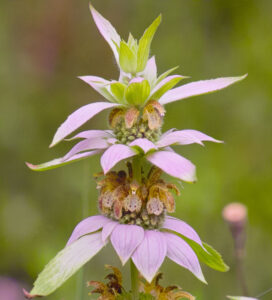
Height:
This plant typically grows between 2 and 3 feet tall with a spread of about 2 feet.
Bloom Time:
Spotted Bee Balm blooms from late spring through early fall (June–September), providing a long-lasting display of intricate flowers.
Features:
-
Flowers: The blooms feature pale yellow corollas with purple spots surrounded by showy bracts that range in color from pink to lavender. These bracts are often mistaken for petals due to their vibrant appearance.
-
Leaves: The narrow, aromatic leaves emit a scent reminiscent of oregano or thyme when crushed.
-
Stems: Square-shaped and pubescent, typical of plants in the mint family.
Natural Habitat
Spotted Bee Balm is commonly found in prairies, meadows, oak savannas, and sandy coastal plains. It thrives in dry, well-drained soils and often grows in areas with full sun exposure. Its native range spans much of the United States east of the Rocky Mountains.
Light Requirements
Full sun is essential for Spotted Bee Balm to thrive. It requires at least six hours of direct sunlight daily but can tolerate partial shade. The more sunlight it receives, the taller and more vibrant its blooms become.
Soil Preference
Spotted Bee Balm prefers sandy or loamy soils that are well-drained. It tolerates nutrient-poor soils and performs well in dry conditions. While it can adapt to slightly acidic environments, overly wet or compacted soils should be avoided.
Growing Conditions
In its natural environment, Spotted Bee Balm flourishes in areas with dry soils and abundant sunlight. It is drought-tolerant once established and self-seeds readily to form dense colonies. This plant does not spread aggressively via rhizomes, making it easy to control in gardens.
Ecological Benefits
Spotted Bee Balm is an ecological powerhouse:
-
Pollinator Magnet: Its nectar-rich flowers attract bees, butterflies (including monarchs), hummingbirds, and beneficial predatory insects
 like wasps.
like wasps. -
Host Plant: It supports endangered species such as the Karner Blue Butterfly when planted alongside wild blue lupine.
-
Pest Control: By attracting predatory wasps, Spotted Bee Balm helps control garden pests like grubs and caterpillars.
-
Biodiversity Boost: Its ability to thrive in poor soils makes it ideal for restoring native habitats and supporting diverse ecosystems.
Garden Uses
Spotted Bee Balm is versatile and can enhance various garden settings:
-
Pollinator Gardens: A must-have for supporting bees, butterflies, and hummingbirds.
-
Wildflower Meadows: Adds vibrant color and ecological value to naturalistic landscapes.
-
Rock Gardens: Thrives in sandy or rocky soils where other plants may struggle.
-
Medicinal Gardens: Known for its antimicrobial properties due to high thymol content in its leaves.
Unique Characteristics That Make Spotted Bee Balm Attractive for Hummingbirds
Attractive Color
Hummingbirds are naturally drawn to the vibrant pinkish-purple bracts surrounding Spotted Bee Balm’s flowers. These bold colors act as visual cues signaling nectar availability.
Flower Shape
The tubular structure of Spotted Bee Balm’s flowers aligns perfectly with the long beaks of hummingbirds, enabling efficient nectar extraction while facilitating pollination.
Nectar Content
Spotted Bee Balm produces abundant nectar throughout its blooming period, ensuring a reliable food source for hummingbirds during migration and nesting seasons.
Blooming Sequence
Spotted Bee Balm’s blooming sequence spans several months (June–September), ensuring that pollinators have access to nectar throughout the growing season. Deadheading spent blooms can further extend flowering time, providing gardeners with vibrant displays while supporting wildlife.
Adaptability
Few plants can match Spotted Bee Balm’s adaptability: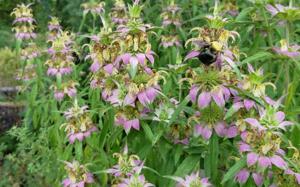
-
Drought Resistance: Thrives in dry conditions thanks to its deep root system.
-
Soil Tolerance: Performs well in sandy or nutrient-poor soils.
-
Low Maintenance: Requires minimal watering once established.
-
Wide Climate Range: Suitable for USDA Zones 3–9, handling both cold winters and hot summers.
-
Non-Invasive Growth Habit: Self-seeds readily but does not spread aggressively via rhizomes.
This adaptability makes Spotted Bee Balm an excellent choice for sustainable gardening practices.
Pollination Partnership
Spotted Bee Balm exemplifies the mutualistic relationship between plants and their pollinators:
-
Hummingbirds & Butterflies: Both species rely on the plant’s tubular flowers for nectar while aiding in pollen transfer.
-
Bees & Wasps: Attracts native bees as well as predatory wasps that help control garden pests.
-
Ecosystem Impact: By supporting diverse pollinator species, Spotted Bee Balm contributes significantly to maintaining healthy ecosystems.
Conclusion
Spotted Bee Balm (Monarda punctata) is more than just a beautiful addition to your garden—it’s an ecological powerhouse that supports pollinators, controls pests, and enhances biodiversity. Whether you’re creating a pollinator garden or restoring native habitats, this plant is an exceptional choice.
Its extended blooming sequence ensures consistent support for wildlife throughout the growing season while its adaptability makes it suitable for challenging garden conditions like sandy soils or intense sun exposure. Additionally, its unique partnership with hummingbirds showcases nature’s intricate design of mutual benefit between plants and pollinators.
By planting Spotted Bee Balm in your garden, you’re not only cultivating beauty but also contributing positively to your local ecosystem—one vibrant bloom at a time!
Fire Pink (Silene virginica): A Fiery Beauty for Hummingbirds
Fire Pink (Silene virginica) is a striking native wildflower that brings vibrant color and ecological value to gardens and natural landscapes. 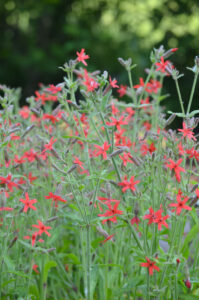 Known for its brilliant red, star-shaped flowers, this perennial plant is a favorite among hummingbirds, making it an excellent choice for pollinator-friendly gardens in the Eastern United States.
Known for its brilliant red, star-shaped flowers, this perennial plant is a favorite among hummingbirds, making it an excellent choice for pollinator-friendly gardens in the Eastern United States.
Key Characteristics
Fire pink is a short-lived perennial that grows between 6 to 24 inches tall. Its stems are hairy and sticky, while the flowers feature five deeply notched petals, creating a star-like appearance. These flowers are tubular, making them ideal for pollinators like hummingbirds.
Zone Fire pink thrives in USDA hardiness zones 4 through 9, encompassing much of the eastern and central United States.
Height This plant typically grows to a height of 12–18 inches but can reach up to 24 inches in optimal conditions.
Bloom Time Fire pink blooms from late spring into early summer, with its flowering period extending from April to July depending on the region.
Features
Bright red, five-petaled flowers with a delicate fringe, held on slender stems above basal rosettes of green leaves. The vivid red blooms of Fire Pink are highly attractive to hummingbirds, who are naturally drawn to bright colors. The flower’s tubular shape and open structure make it easy for hummingbirds to access the nectar deep within. This plant’s fiery appearance not only adds visual interest to your garden but also creates an essential feeding station for these energetic birds.
Natural Habitat
Fire Pink thrives in rocky woodlands, open meadows, and along forest edges. It prefers well-drained soil and sunny to partially shaded conditions. Its natural ability to grow in challenging environments, such as rocky slopes or poor soils, makes it an adaptable addition to gardens.
Care and Maintenance
Fire Pink is relatively low-maintenance but benefits from proper care: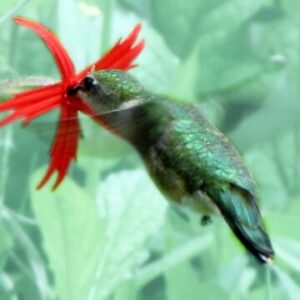
-
Plant in well-drained soil with good sun exposure.
-
Avoid overwatering; the plant is drought-tolerant once established.
-
Deadhead spent blooms to encourage prolonged flowering and prevent self-seeding if desired.
Ecological Benefits
Fire Pink’s nectar-rich flowers are perfectly suited for hummingbirds, which are its primary pollinators. The plant’s bright blooms also attract butterflies and other pollinators, supporting biodiversity in your garden.
Why Choose Fire Pink?
With its stunning red flowers, ease of care, and ability to attract hummingbirds, Fire Pink is a standout choice for gardeners looking to enhance their landscapes while supporting native wildlife. Whether planted in rock gardens, woodland edges, or sunny borders, this fiery wildflower will bring life and color to your garden year after year.
What are the unique characteristics of Fire Pink that attract hummingbirds
Fire Pink (Silene virginica) is a native perennial wildflower with several unique traits that make it highly appealing to hummingbirds. Its vibrant blooms, specialized floral structure, and ecological adaptations ensure it remains a favorite among these pollinators.
- Brilliant Scarlet Flowers
The striking scarlet-red color of Fire Pink’s flowers is one of its most eye-catching features. Hummingbirds are naturally drawn to bright colors 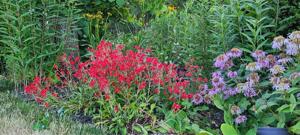 like red, which signal a rich nectar source. The vivid blooms stand out in woodland edges, meadows, and rocky slopes, making them easy for hummingbirds to locate.
like red, which signal a rich nectar source. The vivid blooms stand out in woodland edges, meadows, and rocky slopes, making them easy for hummingbirds to locate.
- Tubular Flower Shape
The flowers of Fire Pink have a narrow tubular structure that is perfectly suited to the long bills and tongues of hummingbirds. This design allows hummingbirds to access nectar deep within the flower while minimizing competition from other pollinators, such as bees and butterflies.
- High Nectar Production
Fire Pink produces abundant nectar, making it an energy-rich food source for hummingbirds. Its blooming period, which lasts from late spring through early summer (April–July), aligns with the active feeding season of Ruby-throated Hummingbirds, ensuring they have access to nourishment during critical times.
- Sticky-Hairy Stems
The plant’s sticky hairs on its stems and calyx act as natural flypaper, deterring ants and small insects from stealing nectar. This adaptation ensures that larger pollinators like hummingbirds can access the nectar without interference.
Adaptability to Rocky and Dry Soils
Fire Pink thrives in challenging environments such as rocky slopes and dry woodlands. Its ability to grow in well-drained soil with partial sun makes it a versatile addition to gardens designed for pollinators.
With its vivid blooms, tubular flowers, and high nectar output, Fire Pink is an essential plant for attracting hummingbirds while adding striking beauty to naturalized landscapes or pollinator-friendly gardens.
Pollination Partnership
The ruby-throated hummingbird is the primary pollinator of fire pink. This mutually beneficial relationship highlights the ecological importance of this native wildflower.
Conclusion
Fire pink is more than just a beautiful addition to your garden—it’s a vital part of the ecosystem that supports pollinators like hummingbirds while providing dazzling color throughout spring and summer. Its adaptability, low-maintenance requirements, and ecological benefits make it an excellent choice for gardeners looking to cultivate native plants that give back to nature. Add fire pink to your garden today for a vibrant splash of red that attracts wildlife and enhances biodiversity!
Video: Fire Pink
Indian Pink (Spigelia marilandica) A Native Gem for Your Garden
Indian Pink is a striking perennial native to the southeastern United States. Sometimes called Pinkroot or Wormgrass, its name reflects both its vibrant appearance and historical medicinal uses.
Key Characteristics
Indian Pink is celebrated for its upright clusters of tubular flowers, which are deep red on the outside and bright yellow inside, flaring at the tips 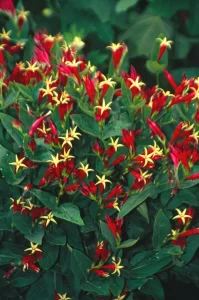 like tiny stars. The plant forms neat clumps of glossy, dark green, ovate leaves arranged oppositely along the stem.
like tiny stars. The plant forms neat clumps of glossy, dark green, ovate leaves arranged oppositely along the stem.
Zone
This perennial thrives in USDA Hardiness Zones 5–9, making it suitable for a wide range of temperate gardens across the eastern and southern U.S.
Height
Mature Indian Pink plants typically reach 1 to 2.5 feet in height, with some robust specimens growing up to 3 feet tall.
Bloom Time
Indian Pink blooms in late spring to early summer, usually from May through June. With proper care, especially deadheading, it may rebloom sporadically into mid-summer.
Features
-
Showy, tubular red and yellow flowers
-
Glossy, dark green foliage
-
Clump-forming habit
-
Long-lived and low-maintenance
-
Deer-resistant and drought-tolerant once established
Natural Habitat
In the wild, Indian Pink is found in moist woodlands, along streambanks, and at the edges of rich, shady forests. Its native range extends from  Indiana to Texas and southeast to Florida.
Indiana to Texas and southeast to Florida.
Light Requirements
Indian Pink prefers partial shade to dappled sunlight, mimicking its woodland origins. It can tolerate full sun if provided with adequate moisture, but too much shade may reduce blooming.
Soil Preference
This plant thrives in moist, well-drained soils rich in organic matter. It tolerates a range of soil types, from slightly acidic to neutral, and can adapt to both wet and dry conditions with proper care.
Growing Conditions
-
Plant in spring or fall for best establishment
-
Water regularly, especially in sunnier spots
-
Mulch to retain soil moisture and suppress weeds
-
Deadhead spent blooms to encourage reblooming
-
Divide clumps every few years to maintain vigor
Ecological Benefit
Indian Pink is a powerhouse for pollinators. Its tubular flowers are a magnet for hummingbirds, butterflies, and other beneficial insects, 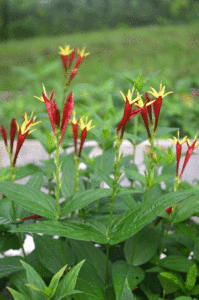 supporting local biodiversity and healthy garden ecosystems.
supporting local biodiversity and healthy garden ecosystems.
Garden Uses
-
Woodland and shade gardens
-
Pollinator and native plant gardens
-
Shady borders and understory plantings
-
Pond-side and bog gardens
-
Unique cut flowers for arrangements
Why Choose Indian Pink?
Indian Pink offers a rare combination of vivid color, adaptability, and ecological value. It’s easy to grow, long-lived, and brings a bold splash of red and yellow to shady spots where few other perennials thrive. Its resistance to deer and drought further enhances its appeal.
Unique Characteristics That Make Indian Pink Attractive for Hummingbirds
Attractive Color
The brilliant red and yellow hues of Indian Pink’s flowers are irresistible to hummingbirds, who are naturally drawn to bright, tubular blooms.
Flower Shape
The long, narrow, upward-facing tubes are perfectly shaped for hummingbird beaks, allowing easy access to nectar while facilitating pollination.
Nectar Content
Indian Pink produces abundant nectar, providing a rich food source for hummingbirds throughout its extended bloom period.
Blooming Sequence
Flowers open sequentially along the stem, ensuring a steady supply of fresh blooms and nectar over several weeks, which keeps pollinators returning.
Adaptability
Its ability to thrive in various light and soil conditions means Indian Pink can support hummingbirds in diverse garden settings, from deep shade to partial sun.
Pollination Partnership
As hummingbirds feed, they transfer pollen from flower to flower, ensuring successful reproduction for the plant and a reliable food source for the birds—a classic win-win partnership.
Video: Spigelia – A Native Perennial for your Garden
Conclusion
Indian Pink (Spigelia marilandica) is a standout native perennial that brings beauty, resilience, and ecological value to any garden. Its dazzling flowers, adaptability, and strong appeal to hummingbirds make it a must-have for gardeners seeking to support pollinators and add vibrant color to shady spaces. Whether you’re designing a woodland retreat or simply want to attract more wildlife, Indian Pink is a choice that will reward you year after year.
Native Shrubs
-
Red Buckeye (Aesculus pavia): A Showstopper for Pollinators and Gardens
Red Buckeye (Aesculus pavia), also known as Firecracker Plant or Scarlet Buckeye, is a native deciduous shrub or small tree prized for its vibrant spring blooms and wildlife value.
Key Characteristics
Red Buckeye is recognized for its upright clusters of tubular red (occasionally yellow) flowers, palmately compound leaves with five leaflets,
 and smooth, light brown seed capsules. The plant typically grows as a multi-stemmed shrub or small tree, with glossy green foliage that drops by late summer.
and smooth, light brown seed capsules. The plant typically grows as a multi-stemmed shrub or small tree, with glossy green foliage that drops by late summer.Zone
This species thrives in USDA Hardiness Zones 6A through 9A, making it suitable for much of the southeastern and south-central United States.
Height
Red Buckeye generally reaches 10–20 feet tall in cultivation, though it can grow up to 25–30 feet in the wild. In Texas and drier regions, it often remains on the shorter end of this range.
Bloom Time
The plant blooms in early to mid-spring, typically from March through May, with showy flower clusters that are among the first to appear in the season.
Features
-
Striking red (or sometimes yellow) tubular flowers in large clusters
-
Deciduous, palmately compound leaves
-
Multi-stemmed, shrubby or small tree form
-
Smooth, light brown seed capsules
-
Leaves drop by late summer, often before other trees
Natural Habitat
Red Buckeye is native to the southeastern U.S., from North Carolina and Florida west to central Texas and north to Illinois. It is commonly found in woodlands, along streams, in thickets, and on rocky hillsides.
Light Requirements
This plant prefers part shade, thriving as an understory shrub. It will bloom in shade but produces more flowers with 3–4 hours of sunlight daily. Protection from harsh afternoon sun is ideal, especially in hotter climates.
Soil Preference
Red Buckeye grows best in deep, well-drained soils—sand, loam, clay, or limestone. It prefers moist, slightly acidic to neutral soils but is
 adaptable to a range of conditions. Overwatering should be avoided to prevent leaf spot diseases.
adaptable to a range of conditions. Overwatering should be avoided to prevent leaf spot diseases.Growing Conditions
-
Plant in spring or fall for best establishment
-
Water regularly, especially during dry spells, but avoid soggy soil
-
Mulch to retain moisture and suppress weeds
-
Prune after flowering to shape and remove dead wood
-
Protect from afternoon sun in hot climates
Ecological Benefit
Red Buckeye is a powerhouse for pollinators. Its nectar-rich flowers attract hummingbirds, bees, and butterflies, while its dense foliage provides shelter for small mammals and birds. The plant supports local biodiversity and helps create a thriving garden ecosystem.
Garden Uses
-
Woodland and shade gardens
-
Pollinator and native plant gardens
-
Specimen tree or shrub in mixed borders
-
Rain gardens and streamside plantings
-
Natural privacy screens
Why Choose Red Buckeye?
Red Buckeye offers a unique combination of ornamental beauty, adaptability, and ecological value. Its early, vibrant blooms provide a crucial nectar source for pollinators, and its manageable size makes it suitable for both small and large gardens. The plant’s resilience and low maintenance needs further enhance its appeal.
Unique Characteristics That Make Red Buckeye Attractive for Hummingbirds
Attractive Color
The vivid red (and occasionally yellow) flowers are highly visible and irresistible to hummingbirds, who are drawn to bright, tubular blooms.

Flower Shape
The long, tubular flowers are perfectly shaped for hummingbird beaks, allowing easy access to nectar and facilitating pollination.
Nectar Content
Red Buckeye’s flowers are rich in nectar, providing an essential early-season food source for hummingbirds and other pollinators.
Blooming Sequence
The plant’s flowers open in succession along the cluster, ensuring a steady supply of nectar over several weeks and keeping pollinators returning throughout the bloom period.
Adaptability
Red Buckeye thrives in a variety of light and soil conditions, making it a reliable nectar source in diverse garden settings, from woodland edges to urban landscapes.
Pollination Partnership
As hummingbirds feed, they transfer pollen between flowers, ensuring successful reproduction for the plant and a reliable food source for the birds—a classic mutualistic relationship.
-
Video: Learn to Grow: Red Buckeye
Red buckeye is quite possibly one of the more attractive spring flowering trees/shrubs. It is low maintenance, long-lived, and an excellent plant for pollinating wildlife. In this Extension Gardener segment, we will be talking all about buckeye and how to grow it!
Conclusion
Red Buckeye (Aesculus pavia) is a standout native shrub or small tree that brings early-season color, wildlife value, and adaptability to gardens. Its showy blooms, strong appeal to hummingbirds, and ecological benefits make it a top choice for gardeners seeking to support pollinators and add vibrant beauty to their landscapes. By planting Red Buckeye, you’re not only enhancing your garden’s visual appeal but also contributing to the health and diversity of your local ecosystem.
-
American Beautyberry (Callicarpa americana): A Vibrant Native for Wildlife and Gardens
American Beautyberry is a native deciduous shrub renowned for its dazzling clusters of purple berries and graceful, arching branches. Sometimes called French Mulberry or Beautyberry, it’s a standout in any landscape.
Key Characteristics
This shrub features long, arching stems with large, coarsely toothed, green leaves. Its most striking feature is the dense clusters of glossy,
 iridescent-purple berries that hug the branches at the leaf axils in fall and winter. In spring and summer, it produces small, pink to lilac flowers that are subtle but attractive to pollinators.
iridescent-purple berries that hug the branches at the leaf axils in fall and winter. In spring and summer, it produces small, pink to lilac flowers that are subtle but attractive to pollinators.Zone
American Beautyberry thrives in USDA Hardiness Zones 6–10, making it suitable for much of the southeastern and south-central United States.
Height
Typically, American Beautyberry grows 3–5 feet tall and wide, but in optimal conditions, it can reach up to 9 feet or even 12 feet in the wild.
Bloom Time
Small pink to lilac flowers appear from late spring through summer (June–July), followed by the development of vibrant berries that ripen from August to November and persist into winter.
Features
-
Clusters of brilliant purple (occasionally white) berries in fall and winter
-
Long, arching branches with large, green, coarsely toothed leaves
-
Deciduous, with yellow-green fall foliage
-
Smooth bark with lenticels on older wood
-
Multi-stemmed, bushy growth habit
Natural Habitat
American Beautyberry is native to the southeastern U.S., commonly found in woodlands, thickets, along woodland edges, and in the understory of pine and oak forests. It prefers climates with mild winters and hot, humid summers.
Light Requirements
This shrub grows well in full sun to partial shade. While it tolerates shade, berry and flower production are best with at least a few hours of direct sunlight each day.
Soil Preference
American Beautyberry is adaptable to a variety of soils, including clay, loam, and sand, but prefers moist, well-drained soil. It tolerates both acidic and neutral pH and can handle less-than-ideal conditions once established.
Growing Conditions
-
Plant in spring or fall for best results

-
Water regularly during the first growing season; drought-tolerant once established
-
Mulch to retain moisture and suppress weeds
-
Prune in late winter or early spring to maintain shape and encourage fuller berry displays
-
Minimal pest or disease issues; low maintenance
Ecological Benefit
American Beautyberry is a powerhouse for wildlife. Its berries are a vital food source for birds, including mockingbirds, robins, and cardinals, as well as small mammals. The flowers attract butterflies and other pollinators. Crushed leaves release compounds that naturally repel mosquitoes, making it useful for people and wildlife alike.
Garden Uses
-
Wildlife and pollinator gardens
-
Shrub borders and mixed hedges
-
Woodland and shade gardens
-
Erosion control on slopes
-
Naturalized plantings and property lines
Why Choose American Beautyberry?
American Beautyberry offers year-round interest, from its lush green foliage and delicate summer flowers to its spectacular fall berries. It’s easy to grow, drought-tolerant, and supports a wide range of wildlife. Its natural mosquito-repelling properties and low maintenance needs make it a practical and beautiful addition to any garden.
Unique Characteristics That Make American Beautyberry Attractive for Hummingbirds
Attractive Color
While the berries are the main attraction for birds, the small pink to lilac flowers provide a subtle but appealing nectar source for hummingbirds and butterflies.
Flower Shape
The short, tubular flowers are accessible to hummingbirds, allowing them to feed easily while pollinating the plant.
Nectar Content
The flowers offer nectar that attracts not only hummingbirds but also a variety of pollinators, supporting garden biodiversity.
Blooming Sequence
Flowers appear in clusters along the stems in early to mid-summer, providing a steady nectar supply before the berries form.
Adaptability
American Beautyberry thrives in a range of light and soil conditions, ensuring it can support pollinators in diverse garden settings.
Pollination Partnership
As hummingbirds and other pollinators visit the flowers, they facilitate cross-pollination, leading to the abundant berry clusters that define the plant in fall.
Conclusion
American Beautyberry (Callicarpa americana) is a stunning native shrub that brings vibrant color, wildlife value, and resilience to gardens. Its showy berries, adaptability, and ecological benefits make it a top choice for gardeners seeking beauty and biodiversity. By planting American Beautyberry, you’ll enjoy a landscape that’s as lively and functional as it is beautiful, supporting birds, pollinators, and even your own outdoor enjoyment.
Video: Beautyberry Plant Profile
-
-
Sweet Pepperbush (Clethra alnifolia) also called Summersweet
Key Characteristics
Sweet Pepperbush, also known as Summersweet, is a deciduous, chalice-shaped shrub native to the eastern United States. It is celebrated for its upright, mounded habit, glossy green leaves, and showy, fragrant white flower spikes that bloom in mid to late summer. The flowers are highly attractive to pollinators, especially hummingbirds and butterflies
.
Zone
Sweet Pepperbush thrives in USDA Hardiness Zones 3 to 8, making it suitable for a wide range of climates across much of the United States

.
Height
At maturity, Sweet Pepperbush typically reaches 5 to 7 feet in height, with a spread of 5 to 6 feet
.
Bloom Time
The plant blooms from early to mid-summer, with flowers appearing from July through August. The bloom period can extend into late summer, providing a valuable nectar source when few other shrubs are flowering
.
Features
-
Fragrant, bottlebrush-like white flower spikes
-
Glossy green, serrated leaves that turn yellow to golden-brown in fall
-
Deciduous foliage
-
Low maintenance and deer resistant
-
Attracts birds, hummingbirds, and butterflies
-
Tolerates wet soils and short periods of drought
Natural Habitat
Sweet Pepperbush is native to moist woodlands, stream banks, swamp margins, and wetland edges throughout the eastern United States. It is commonly found in areas with dappled shade and consistently moist, acidic soils

.
Light Requirements
This shrub is highly adaptable, thriving in full sun to partial shade. In hotter climates, it benefits from afternoon shade to prevent leaf scorch and maintain soil moisture
.
Soil Preference
Sweet Pepperbush prefers moist, well-drained, slightly acidic soils rich in organic matter. It tolerates sandy, loamy, and even clay soils, provided they are not allowed to dry out completely. The plant can also withstand short periods of flooding once established
.
Growing Conditions
-
Water: Requires regular watering, especially during establishment and in dry periods.
-
Mulch: A generous layer of mulch helps retain soil moisture and keep roots cool.
-
Pruning: Prune in late winter or early spring to remove old wood and encourage new growth, as flowers form on new wood.
-
Spacing: Allow 5–6 feet between plants for mature spread
-
.
Ecological Benefit
Sweet Pepperbush is a powerhouse for pollinators. Its nectar-rich flowers attract hummingbirds, bees, and butterflies, while its seeds and foliage provide food and shelter for birds and other wildlife. The shrub also helps stabilize soil in wetland areas and supports native biodiversity
.
Garden Uses

-
Borders and hedges
-
Rain gardens and wetland edges
-
Wildlife and pollinator gardens
-
Naturalized or woodland plantings
-
Foundation plantings
-
Containers (with adequate moisture)
Why Choose Sweet Pepperbush?
Sweet Pepperbush is a versatile, low-maintenance native shrub that brings multi-season interest to the garden. Its adaptability to various light and soil conditions, resistance to deer, and ability to thrive in wet or average soils make it an excellent choice for both novice and experienced gardeners. The fragrant summer blooms and vibrant fall foliage add ornamental value, while its ecological benefits support a healthy garden ecosystem
.
Unique Characteristics That Make Sweet Pepperbush Attractive for Hummingbirds
Attractive Color
The snow-white flower spikes stand out against the dark green foliage, making them highly visible to hummingbirds searching for nectar sources in mid to late summer
.
Flower Shape
Sweet Pepperbush produces dense, upright, bottlebrush-shaped flower clusters. Each tiny flower is perfectly shaped for hummingbirds to access nectar with their slender bills
.
Nectar Content
The flowers are rich in nectar, providing a critical food source for hummingbirds and other pollinators during the summer months when few other shrubs are in bloom
.
Blooming Sequence
Sweet Pepperbush blooms after many spring-flowering shrubs have finished, offering a reliable nectar source during a seasonal gap. The extended bloom period ensures a steady supply of food for hummingbirds
.
Adaptability
This shrub is adaptable to a wide range of garden conditions, from full sun to full shade and from average to wet soils. Its resilience makes it easy to incorporate into diverse garden settings
.
Pollination Partnership
Sweet Pepperbush forms a mutually beneficial relationship with hummingbirds: the birds feed on its nectar, while the plant relies on them (and bees) for pollination, ensuring successful seed set and propagation
-
Video: Summersweet – Fragrant, Pollinators, Fall Color, Native – Clethra Alnifolia
.Conclusion
Sweet Pepperbush (Clethra alnifolia) is a standout native shrub for gardeners seeking beauty, fragrance, and ecological value. Its showy, fragrant summer blooms, adaptability, and strong appeal to hummingbirds and other pollinators make it a must-have for wildlife-friendly landscapes. Whether planted in borders, rain gardens, or naturalized areas, Sweet Pepperbush delivers multi-season interest and supports a thriving garden ecosystem
Native Vines
-
Trumpet Honeysuckle or Coral Honeysuckle (Lonicera sempervirens) A Favorite Among Hummingbirds, Butterflies, and Other Pollinators
Key Characteristics
Coral Honeysuckle (Lonicera sempervirens), also known as Hummingbird Honeysuckle, is a native, non-invasive vine prized for its vibrant,
 trumpet-shaped flowers. The blooms are coral-red on the outside and yellow on the inside, offering a stunning display that attracts hummingbirds, butterflies, and bees. This low-maintenance plant is perfect for adding vertical interest to gardens while supporting local wildlife.
trumpet-shaped flowers. The blooms are coral-red on the outside and yellow on the inside, offering a stunning display that attracts hummingbirds, butterflies, and bees. This low-maintenance plant is perfect for adding vertical interest to gardens while supporting local wildlife.- Height
Coral Honeysuckle can grow up to 10–20 feet long, making it an excellent choice for trellises, fences, arbors, or pergolas. It can also be used as a ground cover if left unsupported.
- Bloom Time
This vine blooms profusely from late spring to early summer, with sporadic flowering continuing into fall. The extended bloom period provides a consistent nectar source for pollinators throughout the growing season.
- Light Requirement
Coral Honeysuckle thrives in full sun to partial shade. While it can tolerate some shade, planting it in sunnier locations will result in more abundant flowering.
- Soil Preference
This vine prefers moist, well-drained soil but is adaptable to a variety of soil types, including sandy or clay soils. It tolerates slightly acidic to neutral pH levels and is drought-tolerant once established.
- Natural Habitat and Growing Conditions
Native to the eastern United States, Coral Honeysuckle is often found in open woodlands, along forest edges, and in meadows. It is well-suited
 for USDA zones 4–9 and performs well in gardens with minimal care. Unlike invasive Japanese Honeysuckle (Lonicera japonica), Coral Honeysuckle grows in a controlled manner and supports native ecosystems.
for USDA zones 4–9 and performs well in gardens with minimal care. Unlike invasive Japanese Honeysuckle (Lonicera japonica), Coral Honeysuckle grows in a controlled manner and supports native ecosystems.- Ecological Benefit
Coral Honeysuckle is a powerhouse for pollinators. Its tubular flowers are rich in nectar, making them a favorite of hummingbirds and butterflies. Bees are also frequent visitors. In late summer and fall, the vine produces small red berries that provide food for songbirds like robins and cedar waxwings. Additionally, its dense foliage offers shelter for birds and other wildlife. By planting Coral Honeysuckle, gardeners can create a vibrant habitat that supports biodiversity while enhancing their landscape’s beauty
VIDEO: The Perfect Native Vine? Why Coral Honeysuckle Deserves a Spot in Your Garden!
Coral Honeysuckle (Lonicera sempervirens) might just be the perfect native vine! This stunning, low-maintenance plant boasts vibrant, tubular red flowers that bloom from spring through fall, attracting hummingbirds, butterflies, and other pollinators. Unlike invasive honeysuckles, this non-aggressive native vine is well-behaved and easy to manage. It thrives in a variety of conditions—whether in full sun or partial shade—and is drought-tolerant once established. Plus, it’s deer-resistant and provides year-round interest with its semi-evergreen foliage. If you’re looking for a beautiful, wildlife-friendly vine that’s as practical as it is eye-catching, Coral Honeysuckle could be the perfect choice for your garden!
Unique Characteristics of Coral Honeysuckle That Make It Attractive to Hummingbirds
Coral Honeysuckle (Lonicera sempervirens) is a native vine celebrated for its ability to attract hummingbirds. Its unique characteristics make it an essential addition to any garden designed to support these fascinating pollinators.
- Tubular Flower Shape
The tubular flowers of Coral Honeysuckle are perfectly tailored to hummingbirds’ long, slender beaks and tongues. This shape allows hummingbirds to access the nectar deep within the blooms while excluding most insects, ensuring a reliable food source for the birds. The flower’s design suggests co-evolution between the plant and hummingbirds, making it an ideal match for their feeding habits.
- Bright Colors
The vibrant red, orange, or yellow hues of Coral Honeysuckle’s flowers act as visual beacons for hummingbirds, who are naturally drawn to
 bright colors. These striking blooms stand out against the foliage, making them easy for hummingbirds to locate even from a distance.
bright colors. These striking blooms stand out against the foliage, making them easy for hummingbirds to locate even from a distance.- Abundant Nectar
Coral Honeysuckle produces copious amounts of nectar, providing the high-energy food hummingbirds need to sustain their rapid wingbeats and active lifestyles. The flowers bloom profusely in late spring and early summer, with sporadic flowering continuing into fall, ensuring a consistent nectar supply throughout the breeding and migration seasons.
- Extended Bloom Period
Unlike many other plants, Coral Honeysuckle blooms on both old and new wood, allowing it to flower continuously over several months. This extended bloom period aligns perfectly with hummingbird activity, supporting them during critical times of the year.
- Ecological Benefits
In addition to attracting hummingbirds, Coral Honeysuckle supports butterflies and bees with its nectar-rich blooms. Its red berries provide food for songbirds like robins and finches in late summer and fall. The vine also serves as a larval host for Spring Azure butterflies and Snowberry Clearwing moths.
By planting Coral Honeysuckle in your garden, you can create a vibrant habitat that not only supports hummingbirds but also enhances biodiversity while adding beauty to your outdoor space.
-
Cross Vine (Bignonia capreolata): A Hummingbird Magnet for Your Garden
Cross Vine is a vigorous, semi-evergreen, woody vine native to the southeastern and south-central United States. Its name comes from the unique cross-shaped pattern seen in a cross-section of its stem.
Key Characteristics
Cross Vine is known for its rapid growth, long trailing or climbing stems, and clusters of showy, trumpet-shaped flowers in vibrant shades of
 orange, red, and yellow with yellow throats. The glossy, dark green leaves often turn reddish-purple in winter, and the vine clings to structures using tendrils tipped with adhesive disks.
orange, red, and yellow with yellow throats. The glossy, dark green leaves often turn reddish-purple in winter, and the vine clings to structures using tendrils tipped with adhesive disks.Zone
Cross Vine thrives in USDA Hardiness Zones 6 to 9, making it suitable for a wide range of temperate and subtropical regions.
Height
This vine can reach impressive heights of 30 to 50 feet, and spreads 6 to 9 feet wide, making it ideal for covering arbors, fences, walls, and trellises.
Bloom Time
Cross Vine blooms heavily in mid to late spring, with flowers often lasting up to four weeks. Intermittent blooms may continue into the summer, especially in favorable conditions.
Features
-
Clusters of fragrant, trumpet-shaped flowers in orange, red, and yellow
-
Glossy, semi-evergreen foliage that darkens in winter
-
Rapid, vigorous growth and strong climbing ability
-
Tolerates a wide range of soils and conditions
-
Attracts hummingbirds, butterflies, and bees
-
Deer and drought tolerant once established
Natural Habitat
In the wild, Cross Vine is found climbing trees in swampy forests, woodlands, floodplains, and along limestone outcrops throughout the southeastern and south-central U.S. It is well adapted to both moist lowlands and upland woods.
Light Requirements
Cross Vine grows in full sun to partial shade, but produces the most abundant flowers with at least 6 hours of direct sunlight daily. It tolerates shade, though flowering may be reduced.
Soil Preference
This adaptable vine thrives in a variety of soils—clay, loam, sand, or chalk—with a preference for moist, well-drained conditions. It tolerates acidic, neutral, or alkaline pH and can withstand brief flooding or drought.
Growing Conditions
-
Plant in spring or fall for best establishment

-
Provide sturdy support for climbing (fence, arbor, wall)
-
Water regularly during the first year; drought tolerant once established
-
Prune after flowering to control size and shape
-
Remove root suckers to prevent unwanted spread
-
Propagate by seed or stem cuttings
Ecological Benefit
Cross Vine is a valuable plant for supporting pollinators. Its early spring blooms provide a critical nectar source for returning hummingbirds and emerging butterflies. The dense foliage offers cover for small wildlife and nesting birds.
Garden Uses
-
Covering arbors, pergolas, fences, and trellises
-
Adding vertical interest to walls and garden structures
-
Groundcover for slopes and banks
-
Woodland and pollinator gardens
-
Naturalizing along woodland edges or stream banks
Why Choose Cross Vine?
Cross Vine combines spectacular spring color, vigorous growth, and wildlife value. It is low-maintenance, adaptable, and resistant to deer and drought. Its ability to quickly cover large structures and attract hummingbirds makes it a standout choice for gardeners seeking both beauty and ecological impact.
Unique Characteristics That Make Cross Vine Attractive for Hummingbirds
Attractive Color
The vivid orange-red and yellow flowers are highly visible and irresistible to hummingbirds, who are naturally drawn to bright, tubular
 blooms.
blooms.Flower Shape
The trumpet-shaped flowers are perfectly suited for hummingbird beaks, allowing easy access to nectar while facilitating pollination.
Nectar Content
Cross Vine produces nectar-rich flowers, providing an abundant food source for hummingbirds during their migration and breeding seasons.
Blooming Sequence
Flowers appear in clusters and open in succession, ensuring a steady supply of nectar over several weeks in spring and sometimes again in late summer.
Adaptability
Cross Vine thrives in a range of light and soil conditions, making it a reliable nectar source for hummingbirds in diverse garden settings.
Pollination Partnership
As hummingbirds feed, they transfer pollen between flowers, ensuring successful reproduction for the vine and supporting local pollinator populations.
Conclusion
Cross Vine (Bignonia capreolata) is a showstopping native vine that brings vibrant color, vertical interest, and ecological value to any garden. Its spectacular blooms, adaptability, and strong appeal to hummingbirds and other pollinators make it a top choice for gardeners seeking to support wildlife while creating a stunning landscape. Plant Cross Vine, and you’ll enjoy a thriving, colorful garden that comes alive every spring with the flutter of hummingbird wings.
Video: Garden Tips: Cross Vine
-
Other Hummingbird Resources
Here’s a complete guide to attracting hummingbirds to your yard. It lists plants, vines and shrubs that are in bloom for spring, summer and fall. Your hummingbirds will always have flowers to feed on.
Here’s a great article that tells everything you need to know about how to choose the best place to hang your hummingbird feeder.
Here’s the best designed hummingbird feeder to use. It’s leak proof, so it won’t attract insects and it’s easy to take apart and clean.
Here’s a comprehensive guide to help you clean your hummingbird feeder for those times when the nectar is not changed soon enough and mold starts to grow.
One of the best Hummingbird feeders that’s easy to take apart and clean is the HummZinger Ultra.
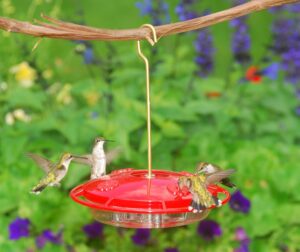
Aspects 12oz HummZinger Ultra With Nectar Guard.
The HummZinger Ultra 12oz Saucer Feeder is one of the best options for a hummingbird feeder that’s both easy to clean and maintain. This top-tier feeder features patented Nectar Guard tips—flexible membranes on the feeding ports that keep flying insects out while still allowing hummingbirds to feed
freely. Plus, it comes with an integrated ant moat to prevent crawling insects from reaching the nectar, and the raised flower ports help divert rain, keeping the nectar fresh.
With a 12 oz capacity, this mid-size feeder offers plenty of space and can be hung or mounted on a post using the included hardware. It has four feeding ports and is made from durable, unbreakable polycarbonate. Whether you’re concerned about bees, wasps, or ants, this feeder is built for easy cleaning and insect protection.
Additional Favorites
-
Hoary Skullcap
-
Blue Sage
These native plants are excellent choices for attracting hummingbirds, providing nectar-rich blooms throughout the growing season. Incorporating these species into your garden supports pollinators while enhancing the natural beauty of your landscape.
If you found this article helpful please share it with your friends using the social bookmarking buttons on the left side of this page. Help everyone to increase their knowledge and enjoyment of feeding hummingbirds. Do it for the hummingbirds! It also helps my ranking so my information will be available to more people. The more people that see this vital information, the more the hummingbirds are helped. Thank for your help. The hummingbirds and I appreciate you very much!
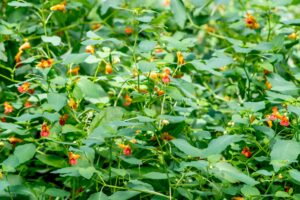
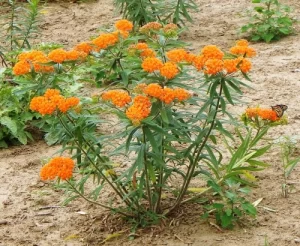
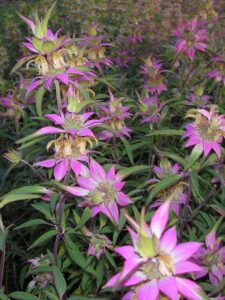 like wasps.
like wasps.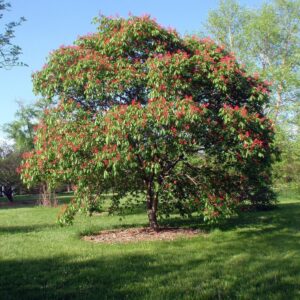 and smooth, light brown seed capsules. The plant typically grows as a multi-stemmed shrub or small tree, with glossy green foliage that drops by late summer.
and smooth, light brown seed capsules. The plant typically grows as a multi-stemmed shrub or small tree, with glossy green foliage that drops by late summer.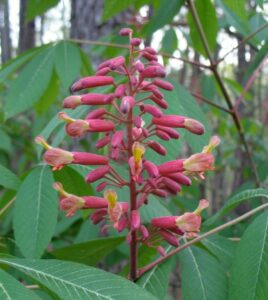 adaptable to a range of conditions. Overwatering should be avoided to prevent leaf spot diseases.
adaptable to a range of conditions. Overwatering should be avoided to prevent leaf spot diseases.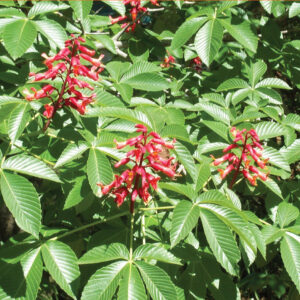
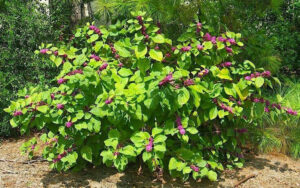 iridescent-purple berries that hug the branches at the leaf axils in fall and winter. In spring and summer, it produces small, pink to lilac flowers that are subtle but attractive to pollinators.
iridescent-purple berries that hug the branches at the leaf axils in fall and winter. In spring and summer, it produces small, pink to lilac flowers that are subtle but attractive to pollinators.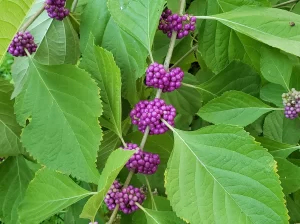
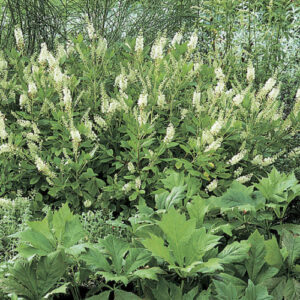

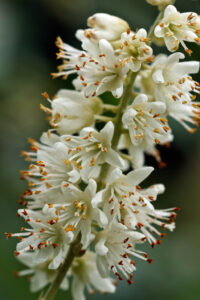
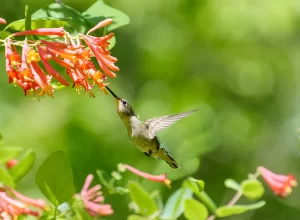 trumpet-shaped flowers. The blooms are coral-red on the outside and yellow on the inside, offering a stunning display that attracts hummingbirds, butterflies, and bees. This low-maintenance plant is perfect for adding vertical interest to gardens while supporting local wildlife.
trumpet-shaped flowers. The blooms are coral-red on the outside and yellow on the inside, offering a stunning display that attracts hummingbirds, butterflies, and bees. This low-maintenance plant is perfect for adding vertical interest to gardens while supporting local wildlife. for USDA zones 4–9 and performs well in gardens with minimal care. Unlike invasive Japanese Honeysuckle (Lonicera japonica), Coral Honeysuckle grows in a controlled manner and supports native ecosystems.
for USDA zones 4–9 and performs well in gardens with minimal care. Unlike invasive Japanese Honeysuckle (Lonicera japonica), Coral Honeysuckle grows in a controlled manner and supports native ecosystems.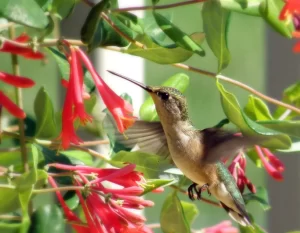 bright colors. These striking blooms stand out against the foliage, making them easy for hummingbirds to locate even from a distance.
bright colors. These striking blooms stand out against the foliage, making them easy for hummingbirds to locate even from a distance.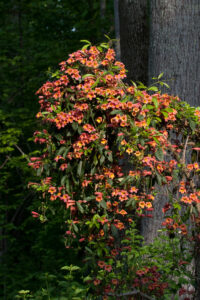 orange, red, and yellow with yellow throats. The glossy, dark green leaves often turn reddish-purple in winter, and the vine clings to structures using tendrils tipped with adhesive disks.
orange, red, and yellow with yellow throats. The glossy, dark green leaves often turn reddish-purple in winter, and the vine clings to structures using tendrils tipped with adhesive disks.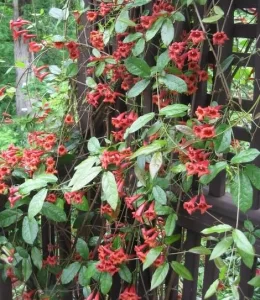
 blooms.
blooms.